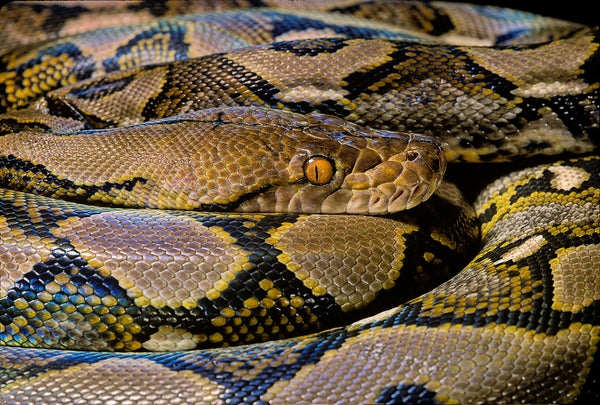Put aside your chicken cutlets and meatloaf and say hello to python curries and satay skewers. Some snake scientists think eating these reptiles—already customary or at least acceptable in parts of the world—might help lessen the damage our food choices have on the environment.
With some eight billion people on the planet today, all of whom require protein to stay healthy, finding new sources of these nutrients is a crucial issue. “The general conundrum we somehow need to solve is: Where do we get the appropriate amounts of protein for a still-growing global population without the big environmental footprint?” says Monika Zurek, a food systems scientist at the University of Oxford, who was not involved in the new research. Humans’ dietary staples, particularly those of Westerners, have serious consequences. The environmental impacts of cattle products such as beef are especially costly: the animals produce nearly 10 percent of the world’s greenhouse gas emissions, and growing food for them spurs deforestation. Pork brings a separate set of environmental hazards, notably water pollution from pig waste. The chicken industry faces similar issues.
But how do you get from the challenge of providing sufficient protein to farming pythons for meat? For Dan Natusch, a herpetologist at Macquarie University in Australia, the idea came about tangentially. He and his colleagues were working with existing commercial python farms in Vietnam and Thailand to determine whether they could distinguish wild-bred snakes from captive-bred ones. During the study, the researchers noticed the farmed pythons’ propensity for speedy growth, which they’ve documented in research published in Scientific Reports on March 14.
On supporting science journalism
If you're enjoying this article, consider supporting our award-winning journalism by subscribing. By purchasing a subscription you are helping to ensure the future of impactful stories about the discoveries and ideas shaping our world today.
“As snake biologists, we already knew that pythons had impressive physiologies,” Natusch says. “After speaking with the python farmers and continuing to monitor their growth rates, their remarkable physiologies became even more apparent.”
Part of the explanation boils down to biology. Pythons, like all snakes, are ectotherms, or cold-blooded animals, which means their body temperature is controlled by their surroundings. This lifestyle makes snakes prone to sunbathing, but it also means that, unlike mammals, ectotherms don’t need to produce heat to keep themselves warm—a major source of energy savings that allows them to efficiently convert food into body mass.
Natusch and his colleagues decided to quantify that efficiency. The team studied reticulated pythons (Malayopython reticulatus) and Burmese pythons (Python bivittatus) on the farms, analyzing what they ate and how quickly they grew.
In particular, the researchers were struck by the pythons’ resilience during long fasts: the animals sometimes went months without eating but also without losing much weight. “Observing the ability of relatively young snakes to go many months without food and remain in a healthy state with minimal loss of body condition was really astounding,” Natusch says. Notably, he and his colleagues think that such resilience could be valuable during a major disruption to the food system, such as what occurred during the early days of the COVID pandemic, when some farmers couldn’t afford to keep feeding their livestock but also couldn’t get them to processors.
“Because we expect even greater global economic and climatic volatility in [the] future, pythons could be a solution for those future challenges,” Natusch says. “Farming pythons could be a big part of the solution for a part of the world that is already suffering from severe protein deficiency,” such as Africa.
Yet Zurek says it’s too early to bet on snakes, despite their impressive metabolic feats, to revolutionize our food systems. She sees a need for many more studies about pythons—especially detailed analyses of the environmental impact of farming them and of their nutritional content, including both proteins and micronutrients. “The current study opens up an interesting step in that direction, but you need to complement that with a whole bunch of additional studies to look at these other aspects before you can really say, ‘Yeah, that’s an option,’” Zurek says.
And of course, it all depends on whether people will take to eating python. Natusch says python meat is “pretty tasty and versatile” and argues that by his tally, a billion people in Southeast and East Asia, as well as parts of Latin America and Africa, already consider snake meat a culturally acceptable food. “It is really just Western cultures (which have few naturally occurring large reptiles) that haven’t been exposed to it,” he says.
